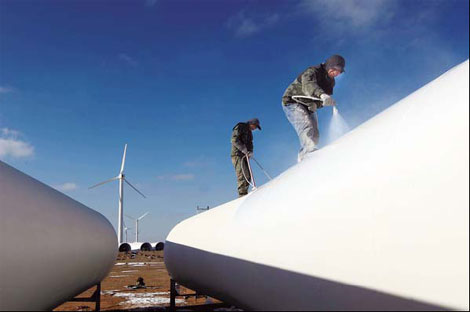-
News >Bizchina
Grid shortcomings taking wind out of energy plan's sails
2011-02-16 11:10
Workers paint wind turbines in Yumen, Gansu province. Due to poor transmission capabilities and grid connection in Northwest China, new wind projects are being built in other provinces. [Photo / Bloomberg]
BEIJING - China, the world leader in wind power by installed capacity, is facing a growing problem with grid connection as more than half of the electricity its wind farms generate goes unused.
According to a report by the State Electricity Regulatory Commission (SERC), unused wind-generated electricity amounted to 2.8 billion kilowatt-hours in the first six months of 2010 due to insufficient transmission capabilities and grid connection.
On-grid power generated by wind and solar facilities in the period accounted for only 0.7 percent of total power generation, the SERC said.
China plans to get 15 percent of its energy from non-fossil fuels by 2020, with wind power expected to contribute two percent and solar one percent.
Experts have pointed to potential wastage in the nation's large-scale development of wind power because power grid upgrades continue to lag behind the expansion of wind turbines.
China needs extensive upgrades to its power grid to take advantage of the wind farms. Its wind-power resources are concentrated primarily in the provinces and regions of Northwest China, such as the Inner Mongolia and Xinjiang Uygur autonomous regions and Gansu province, while most of the energy consumption is along the heavily populated coastline, according to the 2010 China Wind Power Outlook.
With about 4,000 kilometers separating the Xinjiang Uygur autonomous region from Shanghai on the coast, transportation of wind-generated energy from west to east requires high investment in the latest generation of ultra-high voltage (UHV) transmission lines, the Asia Times reported.
The State Grid, China's largest power distributor, plans to spend more than 500 billion yuan ($75.9 billion) to upgrade the grid during the 12th Five-Year Plan (2011-2015). It invested 20 billion yuan in UHV transmission lines from 2006 to 2010.
The SERC report says that places with abundant wind power resources, such as the Inner Mongolia autonomous region, account for 75 percent of unconnected wind-power generation in the country, owing to the lag in grid construction.
The problem has made wind-power operators such as China Wind Power Corp switch to other regions in China that have a better electricity network though inferior wind power resources.
This year, the wind-power operator has most of its new projects in Central and East China, such as Hubei, Anhui, Hunan, and Jiangxi province."Large-scale wind-power generation is impossible in the short term due to inconsistency in the wind patterns," said Jiang Liping, vice-president of the State Grid Energy Research Institution.
"One solution could be to utilize a combination of power sources, including thermal and nuclear power, to increase the flexibility of power generation and regulating systems," Jiang said.
"To overcome this problem, China is developing a smart-grid system for the long term."
